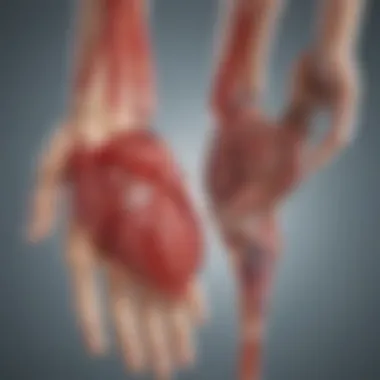Rheumatoid Arthritis and Cardiovascular Disease: An In-Depth Analysis


Overview of Research Topic
Brief Background and Context
Rheumatoid arthritis (RA) is a chronic autoimmune disorder that primarily affects the joints, resulting in inflammation, pain, and eventual disability. This condition also has systemic effects that can influence various organ systems. On the other hand, cardiovascular disease (CVD) encompasses a range of conditions that affect the heart and blood vessels, leading to complications such as heart attacks and strokes. Recent studies indicate a significant relationship between RA and CVD, which highlights the need for an integrated understanding of these two health issues.
Importance in Current Scientific Landscape
The interplay between RA and CVD is an area of increasing attention in the field of rheumatology and cardiology. The chronic and inflammatory nature of RA may contribute to vascular damage and promote atherosclerosis, which is a primary underlying cause of CVD. This connection demands a nuanced approach to treatment and patient management. Recognizing the shared risk factors can help clinicians address not only arthritic symptoms but also mitigate cardiovascular risks in their patients.
Understandably, this relationship underscores a larger narrative in healthcare, where chronic diseases conjoin to exacerbate overall health outcomes.
Methodology
Research Design and Approach
The synthesis of literature regarding RA and CVD typically involves a systematic review of existing studies. Qualitative analyses of patient outcomes and intervention strategies are commonly highlighted. Quantitative data from clinical trials are gathered to support findings, particularly in evaluating the extent of cardiovascular risks in RA patients. The research often uses longitudinal studies, enabling researchers to observe the long-term consequences of these intertwined conditions.
Data Collection Techniques
Data is collected through various techniques, including:
- Surveys: Gaining insights from patients regarding their experiences with both RA and CVD.
- Clinical Trials: Documenting the effects of different treatments on RA symptoms and cardiovascular health.
- Health Registries: Utilizing national health databases to identify patterns and associations in large populations.
"Studying the link between rheumatoid arthritis and cardiovascular disease reveals critical risk patterns that can shape management practices for better health outcomes."
Incorporating these methodologies allows for a comprehensive exploration of the multifaceted relationship between RA and CVD.
Prologue to Rheumatoid Arthritis
Rheumatoid arthritis (RA) is an autoimmune condition that primarily affects the joints, but its implications go far beyond that. Understanding RA is essential in the context of this article as it lays the groundwork for recognizing the connection between it and cardiovascular disease (CVD). The chronic inflammation associated with RA plays a significant role in the development of cardiovascular complications. By comprehending RA's clinical aspects, one can appreciate its broader implications, especially regarding heart health.
Definition and Overview
Rheumatoid arthritis is a chronic inflammatory disorder that chiefly affects the synovial joints. This condition leads to inflammation of the synovial membranes, which can cause pain, swelling, and eventually erosion of the joint surfaces. RA is characterized by symmetrical joint involvement, meaning that if one joint is affected, the corresponding joint on the opposite side of the body is likely to be impacted as well. The disease is also associated with systemic features that can influence various organs.
Epidemiology
Recent studies show that RA affects approximately 1% of the global population, with a higher prevalence in women compared to men, particularly during their middle age. The onset can occur at any age but is most common between the ages of 30 and 60. The epidemiology of RA also highlights its association with genetic and environmental factors, which play a role in its development.
Symptoms and Diagnosis
Symptoms of rheumatoid arthritis can vary widely from person to person. Common signs include:
- Morning stiffness lasting more than 30 minutes
- Joint pain and swelling, primarily in the hands and feet
- Fatigue and general malaise
- Fever and weight loss in some instances
Diagnosing RA typically involves a combination of clinical evaluation and laboratory tests. Doctors often look for specific indicators such as the presence of rheumatoid factor or anti-citrullinated protein antibodies. Imaging techniques like X-rays or MRIs may also assist in assessing joint damage.
Understanding the symptoms and diagnostic criteria of RA enables healthcare providers to initiate appropriate treatment plans promptly, thus mitigating potential long-term complications.
Prolusion to Cardiovascular Disease
Understanding cardiovascular disease (CVD) is crucial in the context of rheumatoid arthritis (RA) as it highlights the overlap between these two significant health issues. CVD encompasses a range of conditions that affect the heart and blood vessels, leading to increased morbidity and mortality among patients. The interplay between RA and CVD is not merely an isolated topic; it holds implications for patient management, treatment strategies, and overall health outcomes.
Definition and Overview


Cardiovascular disease refers to a group of disorders that affect the heart and the blood vessels. This includes conditions such as coronary artery disease, heart arrhythmias, heart failure, and stroke. The term broadly encompasses any dysfunction or abnormality of the cardiovascular system, often associated with risk factors like high blood pressure, high cholesterol, diabetes, and lifestyle choices such as smoking and physical inactivity. A defining feature of CVD is its chronic nature, often developing over years and resulting in significant long-term health consequences.
Epidemiology
The epidemiology of cardiovascular disease reveals staggering statistics. In many countries, CVD is the leading cause of death. According to the World Health Organization, it accounts for approximately 32% of all global deaths, with approximately 17.9 million lives lost annually. The prevalence of cardiovascular conditions is influenced by age, sex, lifestyle, and genetic factors. It’s essential to note that patients with rheumatoid arthritis are at an increased risk of developing CVD. Studies indicate that RA patients have a higher incidence of heart disease compared to those without the condition, underscoring the need for vigilant monitoring and intervention in this population.
Symptoms and Diagnosis
Symptoms of cardiovascular disease can be varied and often depend on the specific type of condition. Common indicators include chest pain, shortness of breath, fatigue, and palpitations. However, in RA patients, these symptoms may overlap with autoimmune manifestations, complicating the diagnosis. Diagnostic processes typically involve a combination of medical history assessment, physical examinations, electrocardiograms, echocardiograms, and stress tests. Healthcare providers must remain vigilant in assessing cardiovascular risk factors in RA patients, including monitoring for hypertension and dyslipidemia.
"Early identification of cardiovascular issues in RA patients can significantly improve treatment outcomes and quality of life."
In summary, recognizing cardiovascular disease's significance in rheumatoid arthritis is vital for healthcare professionals. By understanding CVD's definition, prevalence, and diagnostic challenges, they are better equipped to address the complex health needs of patients at risk.
The Link Between Rheumatoid Arthritis and Cardiovascular Disease
The connection between rheumatoid arthritis and cardiovascular disease is vital for understanding the health implications for individuals suffering from these conditions. Patients with rheumatoid arthritis are not only battling the painful and debilitating effects of swollen joints but also face an increased risk of cardiovascular events. Recognizing this interplay is critical for developing effective management strategies that address both the inflammatory nature of rheumatoid arthritis and its influence on cardiovascular health.
Chronic Inflammation Mechanism
Chronic inflammation is a hallmark of rheumatoid arthritis. The immune system's persistent inflammatory response can lead to various systemic effects. Cytokines such as tumor necrosis factor-alpha (TNF-α) and interleukin-6 (IL-6) can promote the development of atherosclerosis, a key factor in cardiovascular disease.
These cytokines contribute to endothelial dysfunction, which impairs blood vessel function. When blood vessels do not function properly, they cannot adequately regulate blood flow. This can result in an increased susceptibility to plaque formation, which narrows the arteries and can ultimately lead to heart attacks or strokes.
Additionally, chronic inflammation may elevate the levels of other risk factors, including hypertension and dyslipidemia. The overall effect is a concerning convergence of increased inflammatory activity and cardiovascular risk.
Shared Risk Factors
Rheumatoid arthritis and cardiovascular disease share numerous risk factors that can compound health issues for affected patients. Some of these are outlined below:
- Obesity: Increased body weight is associated with both conditions. The excess adipose tissue can exacerbate inflammation.
- Smoking: A well-known risk factor for cardiovascular disease, smoking also seems to play a role in the severity of rheumatoid arthritis.
- Physical Inactivity: Sedentary lifestyles can lead to weight gain and increased cardiovascular risks while also decreasing joint mobility for arthritis patients.
- Age: As both conditions are more prevalent in older populations, age becomes a significant shared risk factor.
- Diabetes: This metabolic disorder increases the risk of developing cardiovascular disease and can affect rheumatoid arthritis patients' overall health outcomes.
Understanding these shared risk factors places greater emphasis on the need for integrated preventive strategies. By targeting these elements proactively, healthcare providers can help lessen the impact of both rheumatoid arthritis and cardiovascular disease.
"Recognizing and addressing the shared risk factors provides a vital opportunity for improving patient outcomes and enhancing quality of life for those affected by both conditions."
Overall, managing rheumatoid arthritis effectively requires a broader consideration of cardiovascular health. The link between these two diseases is not just a matter of coincidence but a complex interaction that demands attention.
Effects of Rheumatoid Arthritis on Cardiovascular Health
The relationship between rheumatoid arthritis (RA) and cardiovascular health is crucial to understanding the broader implications of chronic conditions. Research indicates that patients with RA have a significantly higher risk of developing cardiovascular disease (CVD) compared to the general population. This increased risk can be attributed to several complex mechanisms, each contributing to the deteriorating health of blood vessels and overall heart function.
By delving into the specific ways RA affects cardiovascular health, healthcare professionals can better manage these patients. Addressing both arthritis and cardiovascular conditions concurrently is essential to improving patient outcomes and reducing overall mortality rates. In this section, we will explore two primary aspects: the impact of RA on blood vessels and the process of atherogenesis unique to RA patients.
Impact on Blood Vessels
Rheumatoid arthritis is characterized by chronic inflammation, which has systemic effects extending beyond joint pain and stiffness. Inflammation can lead to significant changes in blood vessel structure and function. The endothelial cells lining the blood vessels become activated in response to inflammatory cytokines. This activation facilitates a range of adverse effects, including increased permeability and heightened adhesion of leukocytes to the vessel walls.
These factors collectively contribute to the pathophysiology of atherosclerosis. Increased endothelial permeability can lead to the deposits of lipids and inflammatory cells in the vessel wall, forming plaque over time. Furthermore, chronic inflammation hampers normal vasodilation. This can contribute to hypertension, which is a known risk factor for various cardiovascular events.
Research has shown that the inflammatory markers associated with RA, such as C-reactive protein (CRP), can predict cardiovascular events. Thus, monitoring these markers can provide insight into a patient’s cardiovascular risk.
Atherogenesis in RA Patients


Atherogenesis, the process by which plaques form in the arteries, is significantly influenced by rheumatoid arthritis. Patients with RA often exhibit an accelerated form of atherogenesis due to the ongoing inflammation associated with their condition.
Key factors contributing to atherogenesis in these patients include:
- Pro-inflammatory cytokines: Elevated levels of cytokines, like tumor necrosis factor-alpha (TNF-α) and interleukin-6 (IL-6), promote the development of atherosclerotic plaques.
- Dyslipidemia: RA patients frequently experience changes in lipid profiles, leading to higher levels of low-density lipoprotein (LDL), often referred to as "bad cholesterol." This can also contribute to plaque formation.
- Increased oxidative stress: The chronic inflammatory state leads to heightened oxidative stress, which damages endothelial cells and promotes plaque formation.
As RA progresses, it exacerbates existing cardiovascular conditions and contributes to new cardiovascular issues. It becomes essential to consider the complex interplay of these factors to develop effective management strategies that focus on both diseases.
"Understanding the relationship between rheumatoid arthritis and cardiovascular health allows for early intervention and comprehensive care strategies."
Cardiovascular Risks Associated with Rheumatoid Arthritis
Understanding the cardiovascular risks associated with rheumatoid arthritis (RA) is crucial for managing the health of affected patients. These individuals are not only coping with joint pain and inflammation, but they also face an elevated risk of cardiovascular disease (CVD). This section will outline how RA contributes to cardiovascular complications, emphasizing the significance of awareness and proactive management.
Increased Risk of Myocardial Infarction
Rheumatoid arthritis markedly increases the risk of myocardial infarction, commonly known as a heart attack. Studies indicate that RA patients have a higher incidence of heart attacks compared to individuals without RA. The reasons for this trend include:
- Chronic Inflammation: The inflammation associated with RA can lead to systemic effects on the cardiovascular system. It can cause endothelial dysfunction and accelerate atherosclerosis, which is the buildup of plaques in the arteries.
- Altered Lipid Profiles: RA may result in abnormal cholesterol levels, contributing to a greater risk of cardiovascular events. Patients often exhibit elevated levels of low-density lipoprotein (LDL) cholesterol and decreased levels of high-density lipoprotein (HDL) cholesterol.
- Medications: Some treatments for RA, such as non-steroidal anti-inflammatory drugs (NSAIDs), may have cardiovascular side effects. Thus, careful consideration of medication is necessary in RA management.
Monitoring heart health in RA patients is essential to mitigate the risk of myocardial infarction. Regular cardiovascular assessments and lifestyle adjustments are important components of a comprehensive healthcare strategy.
"Patients with rheumatoid arthritis should be regularly screened for cardiovascular issues due to their higher risk of heart attack."
Stroke Incidence in RA Patients
The incidence of strokes is also notably higher among patients with rheumatoid arthritis. Understanding this correlation is vital for early detection and prevention strategies. The following points highlight the connection:
- Inflammation and Coagulation: RA is linked to increased inflammation and can lead to hypercoagulability, a condition where blood clots form more easily. This can result in both ischemic and hemorrhagic strokes.
- Systolic Blood Pressure Issues: RA patients often experience changes in blood pressure regulation, leading to hypertension, a well-known risk factor for stroke.
- Lifestyle Factors: Many RA patients may have comorbid conditions such as obesity or diabetes, further escalating the stroke risk. Ensuring weight management and effective diabetes control is vital in these individuals.
Integrating regular screening for stroke risk in RA patients can aid in improving outcomes. Understanding these cardiovascular risks allows clinicians and patients to implement preventive strategies, encouraging a more holistic approach to managing both RA and CVD.
Managing Rheumatoid Arthritis to Reduce Cardiovascular Risk
Managing rheumatoid arthritis is crucial not only for alleviating the joint symptoms but also for reducing the risk of cardiovascular disease. Given the established link between RA and CVD, comprehensive management strategies are necessary. These strategies target inflammation and involve treatment protocols that can enhance overall cardiovascular health.
Chronic inflammation inherent in rheumatoid arthritis accelerates atherogenesis, thereby heightening cardiovascular risk. Therefore, it is vital to address this inflammation through tailored treatment plans. A holistic approach, which includes medication, lifestyle changes, and regular medical supervision, can lead to better health outcomes for patients.
Role of Anti-Inflammatory Treatments
Anti-inflammatory treatments form the backbone of managing rheumatoid arthritis. Drugs such as nonsteroidal anti-inflammatory drugs (NSAIDs) and disease-modifying antirheumatic drugs (DMARDs) are essential. These medications work by reducing inflammation, which helps alleviate both joint symptoms and their associated cardiovascular effects.
Research indicates that achieving disease control can lead to decreased inflammatory markers in the bloodstream. Reductions in these markers correlate with a decreased risk of cardiovascular events. For example, methotrexate, a common DMARD, has shown not only to control RA but also to possibly lower cardiovascular risk by mitigating systemic inflammation.
"Control of inflammation in RA can lead to a marked reduction in cardiovascular events.”
Other anti-inflammatory treatments, such as biological agents, have also proven beneficial. They provide additional options for managing inflammation in those who do not respond well to traditional medications.
Cardioprotective Medications
In addition to anti-inflammatory treatments, cardioprotective medications may further assist in managing cardiovascular risk in rheumatoid arthritis patients. Statins, primarily known for lowering cholesterol levels, also have significant anti-inflammatory properties. This dual action supports cardiovascular health while also managing the inflammatory processes associated with RA.
Patients with rheumatoid arthritis generally should be evaluated for cardiovascular risk factors. If high risk is identified, healthcare providers might recommend statin therapy even if lipid levels are within the normal range. Such proactive measures can significantly decrease the incidence of myocardial infarction and strokes in this population.


Moreover, medications like low-dose aspirin may be recommended for patients with a history of heart disease or those at an increased risk due to RA. Taking these medications requires careful consideration and monitoring by healthcare professionals to assess efficacy and manage potential side effects.
Preventive Strategies for Patients with Both Conditions
Preventive strategies are essential for patients suffering from both rheumatoid arthritis and cardiovascular disease. Understanding how these strategies work can improve patient outcomes and reduce the incidence of serious complications. Patients face a unique risk profile due to the intersection of chronic inflammation associated with RA and the physiological changes that accompany CVD. Effective prevention measures can mitigate these risks while enhancing overall health.
Lifestyle Modifications
Lifestyle modifications play a significant role in managing both rheumatoid arthritis and cardiovascular health. These changes not only address symptoms of RA but also contribute to heart health. The benefits of such alterations include improved quality of life, reduced inflammation, and lower cardiovascular risks. Here are several key lifestyle changes patients should consider:
- Dietary Changes: A heart-healthy diet, rich in omega-3 fatty acids, fruits, and vegetables, can help reduce inflammation. Foods such as salmon, walnuts, and leafy greens are excellent choices. Reducing salt and sugar intake is also beneficial.
- Regular Physical Activity: Engaging in moderate exercise can improve joint function and cardiovascular fitness. Activities like walking, swimming, and cycling can be both joint-friendly and effective.
- Weight Management: Maintaining a healthy weight can decrease stress on joints and lower blood pressure. Weight loss, if needed, can significantly improve symptoms of RA and lower the risk for heart disease.
- Stress Reduction: Stress can exacerbate both RA and cardiovascular disease. Mindfulness practices, yoga, or other relaxation techniques may help manage stress levels.
Patients should consult with healthcare professionals to create tailored lifestyle plans that consider both conditions.
Regular Screening for
Regular screening for cardiovascular disease is crucial for patients with rheumatoid arthritis. Given the heightened risk factors present in these patients, proactive monitoring can lead to early detection and management of cardiovascular issues. This screening can include:
- Blood Pressure Monitoring: Regular checks of blood pressure can help identify hypertension, which is common in individuals with RA.
- Cholesterol Levels: Lipid profiles can assess cholesterol levels, as abnormal readings may indicate increased cardiovascular risk.
- Heart Function Tests: EKGs and echocardiograms can evaluate heart function and detect early signs of heart disease, offering insights for timely intervention.
"Regular health evaluations can change outcomes. Timely interventions and lifestyle alterations can significantly lower complications for those with both RA and CVD."
Patients are encouraged to discuss screening schedules with their healthcare providers, ensuring appropriate tests are performed based on individual risk factors. By prioritizing preventive strategies, patients can actively engage in managing their health, ultimately leading to better overall outcomes.
Future Directions in Research
Research into the relationship between rheumatoid arthritis (RA) and cardiovascular disease (CVD) is crucial for advancing understanding and treatment of both conditions. Given that both RA and CVD can drastically affect patient outcomes and quality of life, focusing on future research directions becomes imperative. New insights can lead to innovative strategies that enhance patient management and care.
New Therapeutic Approaches
One of the most promising areas of research involves the development of novel therapeutic approaches. Targeting the shared pathophysiological mechanisms of RA and CVD offers potential benefits for both disease management and prevention.
- Biologic Therapies: Medications such as tocilizumab, which inhibit interleukin-6, have shown promise not only in alleviating joint inflammation but also in reducing cardiovascular risk.
- Targeted Small Molecules: Agents like JAK inhibitors are under investigation for their ability to modify both inflammation and vascular health.
- Anti-inflammatory Diets: Research into the impact of diet on both RA and cardiovascular health could lead to dietary recommendations that integrate anti-inflammatory foods.
Understanding Genetic Factors
Genetics also plays a vital role in the interplay between RA and CVD. Studies aim to explore how genetic predispositions affect disease severity and patient outcomes. By identifying genetic markers associated with an increased risk of cardiovascular complications in RA patients, tailored therapies can potentially be developed.
- Genome-Wide Association Studies (GWAS): These studies are revealing insights into specific genetic loci that may link RA with CVD.
- Biomarkers: The identification of novel biomarkers could lead to better stratification for patients at high risk of cardiovascular events.
Understanding these genetic components is essential for creating personalized therapeutic strategies that improve health outcomes.
"The focus on genetics may revolutionize the approach to treatment, allowing for more individualized care that is both effective and efficient."
Future research must continue to focus on these avenues, as integrating new knowledge into clinical practice may reduce the burdens associated with RA and CVD, ultimately enhancing life for patients worldwide.
Finale
Summary of Key Points
The major points discussed in the article include:
- Chronic Inflammation: The connection stems largely from persistent inflammation found in both RA and CVD. This inflammation is a catalyst for vascular damage, contributing to complications in cardiovascular health.
- Shared Risk Factors: Conditions such as hypertension, obesity, and smoking are frequent in both populations. This leads to a compounded risk for patients suffering from both diseases.
- Impact of RA on Cardiovascular Health: Evidence suggests that RA patients experience enhanced atherogenic processes, increasing their risk for events like heart attacks or strokes.
- Management Strategies: The article touches on the importance of anti-inflammatory treatments and cardioprotective medication, highlighting that managing RA effectively can help reduce cardiovascular risk.
- Preventive Strategies: Emphasizing lifestyle changes and regular health screenings can lead to better long-term health outcomes for these patients.
- Future Directions: Innovative therapeutic approaches and further genetic research are crucial for tailoring treatments for RA and CVD.
Implications for Clinical Practice
Understanding the link between rheumatoid arthritis and cardiovascular disease allows healthcare professionals to adopt a more holistic approach to patient management. Recognizing that RA patients are at greater risk for cardiovascular complications is vital. Here are some clinical considerations:
- Comprehensive Assessments: Patients with rheumatoid arthritis should undergo regular cardiovascular assessments. Early detection of cardiovascular issues can facilitate timely intervention.
- Integrated Treatment Plans: A multidisciplinary approach, integrating rheumatology and cardiology, is essential. This fosters collaboration among healthcare providers to optimize treatment plans for patients with both conditions.
- Patient Education: Educating patients about warning signs of cardiovascular disease is vital. This empowers them to recognize issues early and seek necessary care.
- Encouraging Lifestyle Changes: Clinicians should actively promote lifestyle modifications such as a balanced diet, exercise, and smoking cessation. These changes can significantly reduce cardiovascular risk.



